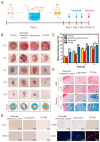Recent Review on Biological Barriers and Host-Material Interfaces in Precision Drug Delivery: Advancement in Biomaterial Engineering for Better Treatment Therapies
- PMID: 39204421
- PMCID: PMC11360117
- DOI: 10.3390/pharmaceutics16081076
Recent Review on Biological Barriers and Host-Material Interfaces in Precision Drug Delivery: Advancement in Biomaterial Engineering for Better Treatment Therapies
Abstract
Preclinical and clinical studies have demonstrated that precision therapy has a broad variety of treatment applications, making it an interesting research topic with exciting potential in numerous sectors. However, major obstacles, such as inefficient and unsafe delivery systems and severe side effects, have impeded the widespread use of precision medicine. The purpose of drug delivery systems (DDSs) is to regulate the time and place of drug release and action. They aid in enhancing the equilibrium between medicinal efficacy on target and hazardous side effects off target. One promising approach is biomaterial-assisted biotherapy, which takes advantage of biomaterials' special capabilities, such as high biocompatibility and bioactive characteristics. When administered via different routes, drug molecules deal with biological barriers; DDSs help them overcome these hurdles. With their adaptable features and ample packing capacity, biomaterial-based delivery systems allow for the targeted, localised, and prolonged release of medications. Additionally, they are being investigated more and more for the purpose of controlling the interface between the host tissue and implanted biomedical materials. This review discusses innovative nanoparticle designs for precision and non-personalised applications to improve precision therapies. We prioritised nanoparticle design trends that address heterogeneous delivery barriers, because we believe intelligent nanoparticle design can improve patient outcomes by enabling precision designs and improving general delivery efficacy. We additionally reviewed the most recent literature on biomaterials used in biotherapy and vaccine development, covering drug delivery, stem cell therapy, gene therapy, and other similar fields; we have also addressed the difficulties and future potential of biomaterial-assisted biotherapies.
Keywords: biological barriers; biomaterial; drug delivery; drug molecule; nanotechnology; precision therapy.
Conflict of interest statement
The authors declare no conflicts of interest.
Figures









Similar articles
-
Biomaterial-assisted biotherapy: A brief review of biomaterials used in drug delivery, vaccine development, gene therapy, and stem cell therapy.Bioact Mater. 2022 Jan 19;17:29-48. doi: 10.1016/j.bioactmat.2022.01.011. eCollection 2022 Nov. Bioact Mater. 2022. PMID: 35386442 Free PMC article. Review.
-
Engineering precision nanoparticles for drug delivery.Nat Rev Drug Discov. 2021 Feb;20(2):101-124. doi: 10.1038/s41573-020-0090-8. Epub 2020 Dec 4. Nat Rev Drug Discov. 2021. PMID: 33277608 Free PMC article. Review.
-
Engineering nano-drug biointerface to overcome biological barriers toward precision drug delivery.J Nanobiotechnology. 2022 Aug 31;20(1):395. doi: 10.1186/s12951-022-01605-4. J Nanobiotechnology. 2022. PMID: 36045386 Free PMC article. Review.
-
Hydroxyapatite: A journey from biomaterials to advanced functional materials.Adv Colloid Interface Sci. 2023 Nov;321:103013. doi: 10.1016/j.cis.2023.103013. Epub 2023 Oct 7. Adv Colloid Interface Sci. 2023. PMID: 37839281 Review.
-
Nanogel: A versatile drug delivery system for the treatment of various diseases and their future perspective.Drug Deliv Transl Res. 2024 Aug 5. doi: 10.1007/s13346-024-01684-w. Online ahead of print. Drug Deliv Transl Res. 2024. PMID: 39103593 Review.
References
-
- Salahshoori I., Golriz M., Nobre M.A.L., Mahdavi S., Eshaghi Malekshah R., Javdani-Mallak A. Simulation-based approaches for drug delivery systems: Navigating advancements, opportunities, and challenges. J. Mol. Liq. 2024;395:123888. doi: 10.1016/j.molliq.2023.123888. - DOI
Publication types
Grants and funding
LinkOut - more resources
Full Text Sources

